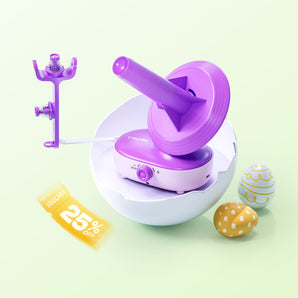Crochet is a timeless and versatile craft that transforms simple yarn into beautiful, functional, and artistic creations.
Whether you’re a beginner picking up your first hook or an advanced crocheter seeking new inspiration, the right crochet tips can make your projects more enjoyable, successful, and rewarding.
In this comprehensive guide, you’ll find expert advice, practical solutions, and creative ideas to help you elevate your crochet skills at every level.
Tips for Beginner Crocheters

Starting your crochet journey can be both exciting and overwhelming. Here are foundational crochet tips to set you up for success:
-
Start with the Right Hook and Yarn
- Choose a medium (worsted) weight yarn in a light color—this makes stitches easier to see and manage.
- Opt for an ergonomic or aluminum crochet hook in size H/8 (5.0mm) or I/9 (5.5mm), which is comfortable for most beginners.
Not sure which crochet hook to use? Check out Caydo’s Crochet Hook Size Chart for a clear, easy-to-follow guide that helps you choose the perfect hook for every project.
-
Master the Slip Knot and Chain Stitch
- The slip knot is your starting point for most projects. Practice making a secure but adjustable knot.
- The chain stitch forms the foundation row; keep your chains even and not too tight.
-
Learn the Basic Stitches
- Single crochet (sc): Simple, dense, and great for beginners.
- Half double crochet (hdc): Slightly taller, works up quickly.
- Double crochet (dc): Creates a looser, more open fabric.
Practice these stitches until you can recognize and count them easily.
-
Practice Consistent Tension
Try to keep your yarn and stitches even—not too tight, not too loose. This ensures your fabric looks neat and uniform.
-
Count Your Stitches
Always count your stitches at the end of each row or round to avoid accidental increases or decreases.
-
Don’t Be Afraid to Frog (Rip Out)
Mistakes happen! “Frogging” (ripping out stitches) is part of the learning process. It’s better to fix errors early than to struggle later.
-
Use Stitch Markers
Place markers at the beginning of rounds, pattern repeats, or tricky sections to keep track of your work.
-
Find Helpful Resources
Explore online tutorials, crochet books, and local craft groups for support and inspiration.
📌Ready to start your crochet journey? Dive into this beginner-friendly guide on How to Crochet and create your first masterpiece today!
Tips for Improving Your Crochet Skills (Intermediate Level)
Ready to take your crochet to the next level? These tips will help you build confidence and skill:
Learn to Read Crochet Patterns
- Familiarize yourself with pattern abbreviations (e.g., sc, dc, ch, sl st) and how patterns are structured.
- Practice following simple patterns to build understanding.
Understand Gauge
- Gauge measures how many stitches and rows fit into a specified area, usually 4 inches.
- Make a gauge swatch before starting projects where size matters (like garments).
Practice Different Stitch Techniques
- Try new stitches like treble crochet (tr) and slip stitch (sl st)
- Learn basic shaping: increasing (adding stitches) and decreasing (removing stitches) to create curves and angles.
Explore Different Yarn Weights and Fibers
Experiment with cotton, wool, or acrylic yarns in various weights to see how they affect drape, texture, and appearance.
📌Confused about which yarn to choose? Explore Caydo’s guide to the different Types of Yarn and find the perfect match for your next creative project!
Learn Basic Color Changes
Practice changing colors at the end of a row or in the middle of a project for stripes and patterns.
📌Want to add stunning color transitions to your crochet projects? Learn how in this easy-to-follow guide on How to Change Colors in Crochet!
Weave in Ends Neatly
Use a yarn needle to weave yarn tails securely in multiple directions for a tidy, lasting finish.
Block Your Projects
Blocking involves wetting or steaming your finished piece and shaping it to size. This evens out stitches and improves drape.
Tips for More Advanced Crocheters
If you’re comfortable with the basics, challenge yourself with these advanced crochet tips:
Explore Texture and Stitch Combinations
Mix different stitches, such as bobble, popcorn, or shell stitches, for unique textures and patterns.
Learn Intarsia and Fair Isle Crochet
Master intarsia (color blocks) and Fair Isle (stranded colorwork) techniques for intricate designs.
Master Advanced Shaping Techniques
Practice complex increases, decreases, and short rows for garment construction and 3D forms.
📌Master the art of shaping your crochet projects! Learn the essential technique of decreasing with this easy-to-follow guide on How to Decrease in Crochet.
Design Your Own Projects
Start sketching ideas and writing simple patterns. Experiment with swatches to test stitch combinations.
Experiment with Tunisian Crochet
Try Tunisian crochet, which uses a longer hook to create a fabric that’s a blend of crochet and knitting.
Learn Filet Crochet and Lace
Explore filet crochet (creating images with open and filled mesh) and intricate lace patterns for decorative projects.
General Crochet Tips for Everyone
No matter your experience, these universal crochet tips will help you enjoy the craft to the fullest:
✅Take Breaks: Stretch your hands and wrists regularly to prevent fatigue.
✅Use Good Lighting: Proper lighting helps you see stitches and avoid mistakes.
✅Organize Your Supplies: Keep hooks, yarn, scissors, and patterns in a dedicated space.
✅Invest in Quality Tools: Comfortable hooks and sharp scissors make a big difference.
✅Join Crochet Communities: Connect with others for support, ideas, and feedback.
✅Don’t Compare Yourself to Others: Focus on your progress and enjoy the process.
✅Have Fun! Crochet is about creativity and relaxation—embrace the journey.
Troubleshooting Common Crochet Problems
Encountering issues is normal. Here’s how to fix common crochet mistakes:
Uneven Tension
Relax your grip and practice regularly. Try different hooks if needed.
Missed Stitches
Count stitches at the end of each row and use stitch markers in complex patterns.
Dropped Stitches
If you notice a gap or loose loop, stop and gently pull back to the error, then redo the stitches.
Holes in Your Work
Check your tension and ensure you’re inserting the hook in the correct place for each stitch.
Curling Edges
Curling can be caused by using the wrong hook size or tight tension. Try going up a hook size or blocking your project.
Conclusion
Crochet is a rewarding and endlessly creative craft. By applying these crochet tips—whether you’re just starting out or mastering advanced techniques—you’ll see improvement in your projects and enjoy the process even more.
Remember, practice and patience are your best tools. Keep exploring, learning, and most importantly, have fun with your crochet journey!
Ready to start your crochet journey? Get inspired with fun and easy Crochet Ideas for Beginners that are perfect for your first projects!
Frequently Asked Questions (FAQs)
What is the best way to hold a crochet hook?
There isn't one single "best" way to hold a crochet hook, as it often comes down to personal preference and what feels most comfortable for your hand and wrist. Many crocheters use the knife grip, holding the hook like a dinner knife for more control, especially with larger projects. Others prefer the pencil grip, which can be gentler on the wrist and is often favored for more delicate work. Experimenting with both styles will help you determine which grip allows for the most comfortable and efficient crocheting.
How do I prevent my yarn from splitting?
To minimize yarn splitting, it's beneficial to choose a smooth, high-quality yarn that is tightly plied rather than one that is loosely spun. Additionally, ensuring you are using the correct crochet hook size for your chosen yarn can make a difference. When inserting your hook into a stitch, aim to go cleanly through the center of the stitch rather than trying to force it between the individual strands of the yarn.
How do I read a crochet pattern for beginners?
For beginners tackling crochet patterns, the first step is to familiarize yourself with common crochet abbreviations such as 'ch' for chain, 'sc' for single crochet, and 'dc' for double crochet.1 Typically, a pattern will begin with a list of the necessary materials, the gauge information, and a key defining the abbreviations used throughout. You'll then follow the instructions line by line or round by round, consistently referring back to the abbreviation key as you work through the steps.
What is the difference between US and UK crochet terms?
It's crucial to be aware that crochet stitch names often have different meanings depending on whether a pattern uses US or UK terminology. For instance, what is known as a single crochet (sc) in US terms is referred to as a double crochet (dc) in UK terms. Similarly, a US double crochet (dc) corresponds to a UK treble crochet (tr). Therefore, always make it a priority to carefully check which terminology standard the pattern you are using follows to avoid confusion and ensure your project turns out as intended.








![[Must-have] Knitting Yarn and Wire Set - Caydo](http://www.caydo.com/cdn/shop/files/3_4c349a4b-7e4d-4fa8-b6df-6561cf08410c.jpg?v=1731059827&width=298)
![[Must-have] Knitting Yarn and Wire Set - Caydo](http://www.caydo.com/cdn/shop/files/1_c1a8ec5f-79f5-4c02-b655-aaba689678cf.jpg?v=1731060862&width=298)










